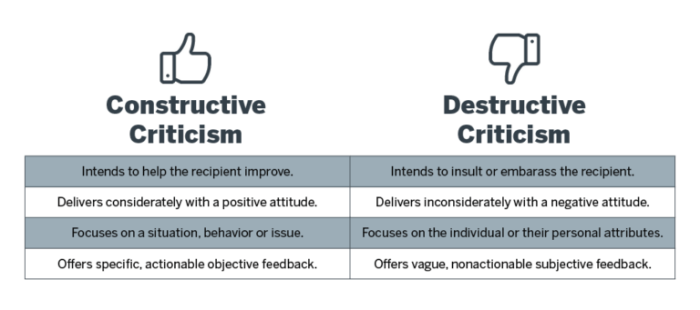How to respond criticism online is a crucial skill in today’s digital landscape. Navigating online interactions requires understanding the nuances of different types of criticism, from constructive feedback to personal attacks. This guide delves into recognizing patterns, distinguishing between helpful and harmful criticism, and crafting measured responses.
This exploration will cover various strategies for handling different online situations. From factual errors to outright harassment, we’ll examine how to respond effectively while maintaining your composure and online safety.
Understanding Online Criticism: How To Respond Criticism Online
Navigating the online world often involves encountering criticism, both expected and unexpected. This can range from constructive feedback to outright negativity, making it crucial to understand the different forms and emotional responses it triggers. This understanding empowers us to respond effectively and maintain our well-being.Online criticism takes many shapes and sizes, reflecting a wide spectrum of intentions and motivations.
Recognizing these diverse forms allows for more nuanced and appropriate responses.
Different Types of Online Criticism
Online criticism isn’t a monolithic entity. It encompasses various types, each with its own characteristics and potential impact. Understanding these differences is key to distinguishing between legitimate feedback and unproductive negativity. Some common types include:
- Constructive Criticism: This type focuses on specific aspects of a post or action, offering suggestions for improvement. It often highlights areas where a particular approach could be enhanced or refined. For example, a constructive critique might point out a grammatical error in a post or suggest a better way to frame an argument.
- Destructive Criticism: This type attacks the person rather than the issue, often resorting to personal insults, generalizations, and name-calling. It aims to harm or belittle rather than help improve. An example could be a comment that labels a post as “stupid” or “irresponsible,” without providing any specific examples or evidence.
- Troll Comments: These are deliberately provocative comments designed to elicit strong reactions. Their intent is not to engage in a constructive discussion but to incite conflict or simply disrupt the conversation. A troll might post inflammatory remarks or ask loaded questions, specifically seeking to provoke an argument.
- Misinformation/Disinformation: This type of criticism involves the spreading of inaccurate or fabricated information. The goal is to mislead or damage reputation. Examples include the deliberate spread of rumors or the fabrication of evidence to support a false accusation.
Emotional Responses to Online Criticism
Online criticism can evoke a range of emotional responses. Understanding these reactions is crucial for managing their impact. Some common responses include:
- Anger: This is a common reaction to perceived unfairness or negativity. It can be fueled by feeling attacked or misunderstood. This strong emotion can hinder a rational response to the criticism.
- Hurt: Personal attacks or criticism can be deeply hurtful, especially when they target vulnerabilities. This emotion can be overwhelming and affect self-esteem.
- Frustration: The effort required to deal with repeated or unproductive criticism can lead to frustration. This feeling can make it difficult to engage constructively with the situation.
- Fear: The fear of negative consequences, such as loss of reputation or community, can be a powerful motivator for avoiding online interaction. This can result in a reluctance to engage in discussions or offer opinions.
Recognizing Patterns in Online Criticism
Identifying patterns in the way you’re criticized online can be a valuable tool for managing the impact of negativity. This involves paying attention to recurring themes, types of criticism, and the timing of these interactions.
Navigating online criticism can be tricky, but a proactive approach is key. Instead of getting defensive, consider how you can use features like those found in the user engagement features framework to foster a more constructive dialogue. Think about how the responses you craft could be seen as opportunities for growth, not just as reactions to negativity.
This can be achieved by understanding the context, considering the tone, and focusing on providing useful information and solutions.
Distinguishing Between Constructive and Destructive Criticism
Not all online criticism is created equal. The difference between constructive and destructive criticism lies in intent, tone, focus, and language.
| Feature | Constructive Criticism | Destructive Criticism |
|---|---|---|
| Intent | To help improve | To harm or belittle |
| Tone | Respectful and helpful | Aggressive and insulting |
| Focus | Specific issues | Personal attacks |
| Language | Specific examples | Generalizations and name-calling |
Responding to Online Criticism
Navigating online criticism requires a delicate balance of self-preservation and respectful engagement. It’s crucial to approach these interactions with a calm demeanor and a clear understanding of the types of criticism you’re facing. This proactive approach allows for measured responses that address concerns without escalating the situation.Understanding your audience and the context of the criticism is vital. Are you responding to a passionate fan, a disgruntled customer, or a troll?
Tailoring your response to the specific situation is key to achieving a positive outcome.
Crafting Composed Responses
A measured response is essential for maintaining your credibility and professionalism online. Avoid reacting impulsively. Take a moment to consider your words before hitting the “reply” button. This allows you to articulate your point clearly and concisely.Consider these strategies:
- Acknowledge the criticism: Acknowledging the criticism, even if you disagree, demonstrates that you’re listening and willing to engage.
- Remain calm and respectful: Avoid raising your voice or resorting to personal attacks. Maintaining a calm and respectful tone helps de-escalate the situation.
- Focus on the issue: Instead of getting sidetracked by irrelevant points, concentrate on addressing the specific concerns raised in the criticism.
- Provide supporting evidence: If possible, back up your claims with evidence or data to strengthen your argument.
Handling Aggressive or Personal Attacks
Aggressive or personal attacks can be challenging to manage online. It’s important to recognize that these attacks often stem from a desire to provoke or derail the conversation. Don’t engage in a back-and-forth argument with an attacker.
- Recognize the intent: Understanding the attacker’s motivation can help you to respond more effectively.
- Ignore the attack: Sometimes, the best response to a personal attack is to ignore it entirely.
- Respond with a calm statement: If you choose to respond, do so with a calm, neutral statement that addresses the factual inaccuracies, but avoids personal remarks.
- Seek help if necessary: If the attacks become abusive or threatening, consider contacting the platform’s administrators or seeking support from trusted sources.
Examples of Polite Yet Firm Responses
Effective responses demonstrate both politeness and firmness. These responses show that you are willing to engage in a constructive dialogue while maintaining your ground.
- Criticism Type: Factual error. Example: “I appreciate you pointing out the error. My previous statement about X was inaccurate. The correct information is Y. Here’s a link to the source: [link].
”
- Criticism Type: Personal opinion. Example: “I understand that you have a different perspective on X. While I respect your opinion, I stand by my position based on [evidence/reasoning].”
- Criticism Type: Misunderstanding. Example: “My intention wasn’t to imply [misunderstanding]. I meant to say [clarification]. I hope this clarifies my position.”
Responding to Different Criticism Types
A tailored approach is essential for different types of online criticism. Here’s a table outlining various criticism types and suggested responses:
| Criticism Type | Suggested Response |
|---|---|
| Factual Error | Politely correct the error with supporting evidence. |
| Personal Opinion | Acknowledge the opinion, but don’t engage in a debate. |
| Misunderstanding | Clarify your position without resorting to defensiveness. |
| Attacking Tone | Acknowledge the tone, but don’t let it provoke a negative response. |
Managing the Online Environment

Navigating the online world requires more than just knowing how to respond to criticism. Effective online interaction involves proactively managing the environment to prevent conflicts from escalating and fostering positive engagement. This involves setting clear boundaries, de-escalating conflicts, and recognizing the potential pitfalls of certain online communities.Understanding the online environment is crucial for maintaining a healthy and productive online presence.
By proactively managing interactions, individuals can avoid unnecessary negativity and foster respectful discourse.
Setting Boundaries in Online Interactions
Establishing clear boundaries is paramount to managing online interactions effectively. Defining limits for engagement ensures that individuals don’t get swept up in unproductive or harmful exchanges. This involves recognizing when to disengage from a conversation, avoid inflammatory language, and not feel obligated to respond to every comment. Setting boundaries is about self-preservation in the digital space. It’s a proactive measure to prevent emotional burnout and maintain mental well-being.
Managing Online Interactions to Prevent Escalation
Preventing escalation is key to maintaining a positive online experience. Proactive measures, such as avoiding overly emotional responses, can significantly reduce the risk of conflict. It’s essential to understand that online interactions can be misinterpreted, so maintaining a calm and measured tone is critical. Using clear and concise language, avoiding sarcasm or humor that could be misinterpreted, and actively listening to opposing viewpoints are important strategies.
De-escalating Online Conflicts
De-escalation techniques are crucial for resolving online disputes peacefully. Recognizing the signs of escalating conflict is vital. This involves identifying emotionally charged language, personal attacks, and inflammatory rhetoric. Responding with empathy, acknowledging opposing viewpoints, and offering constructive feedback are effective de-escalation techniques. Acknowledging the other person’s perspective, even if you don’t agree, can help diffuse the situation.
Identifying and Avoiding Toxic Online Communities
Identifying toxic online communities is an important aspect of online safety. Such communities often feature bullying, harassment, and discrimination. Recognizing patterns of negativity, negativity, and aggressive behavior is key. Paying attention to the overall tone of a community and the level of engagement can help identify potential toxicity. Look for a lack of moderation, repeated attacks on individuals, or a consistent pattern of personal insults.
Avoid communities that consistently prioritize negativity over constructive discussion.
Strategies for Managing Online Interactions
| Strategy | Description |
|---|---|
| Setting Boundaries | Defining clear limits for online engagement, including the types of interactions you’ll participate in, the amount of time you’ll spend online, and the tone you’ll use. |
| De-escalation | Techniques for calming a heated exchange, such as using “I” statements, acknowledging opposing viewpoints, and focusing on finding common ground. |
| Community Awareness | Recognizing and avoiding online communities that prioritize negativity, harassment, or discrimination over constructive dialogue. |
| Content Moderation | Strategies for managing the content you share online, such as verifying information, avoiding inflammatory language, and considering the potential impact of your words on others. |
Maintaining Your Online Presence
Cultivating a positive online image is crucial in today’s digital landscape. A well-managed online presence can enhance personal and professional opportunities, while a poorly managed one can have detrimental effects. Understanding how to navigate the digital sphere effectively is a key skill in the modern world.A proactive approach to online reputation management is essential for maintaining a positive image.
This involves understanding your online footprint, recognizing potential pitfalls, and implementing strategies to mitigate negativity. This proactive approach allows you to shape your online persona rather than reacting to external influences.
Navigating online criticism can be tricky, but remember, a measured response can make all the difference. Learning how to effectively handle feedback is crucial, much like optimizing your Google Ads campaigns for maximum conversions. For example, check out these 8 techniques that’ll double your Google AdWords conversion rate to see how strategic approaches can transform results. 8 techniques thatll double your google adwords conversion rate.
Ultimately, a calm and considered approach to online criticism can help you maintain a positive online presence.
Proactive Monitoring
Regularly checking your online presence is vital for maintaining a positive image. This includes monitoring social media accounts, search engine results, and any other platforms where you might be mentioned. Identifying and addressing negative comments promptly can prevent issues from escalating. A proactive approach is crucial for managing potential problems before they become significant.
Reputation Management
Strategies for shaping your online persona are essential for maintaining a positive image. This includes controlling the content you share and ensuring that your online activity reflects your desired image. Active engagement in constructive conversations and participation in relevant communities can reinforce a positive perception. Thoughtful and considerate responses to online criticism, even negative ones, can greatly enhance your online reputation.
Navigating online criticism requires a delicate touch. Don’t get defensive, but acknowledge valid points. Responding thoughtfully and professionally is key, especially when dealing with the legal ramifications of online marketing. For example, understanding legal issues facing online marketers can help you avoid future problems and formulate better responses to online feedback. Ultimately, a calm and considered approach is the best way to handle criticism constructively.
It’s important to project a professional and positive demeanor in all online interactions.
Constructive Interaction
Prioritizing respectful and helpful engagement is crucial for maintaining a positive online image. Focus on providing value and contributing meaningfully to discussions. Refrain from engaging in arguments or negativity. Respectful communication and constructive feedback are vital in fostering a positive online environment. Responding to criticism with thoughtful consideration and solutions is key to demonstrating your commitment to constructive engagement.
Offline Focus
Balancing online and offline interactions is vital for a healthy mental and social life. Excessive online activity can lead to burnout or negatively affect real-life relationships. Maintaining a healthy balance between online and offline interactions is crucial. Make sure your online persona reflects your real-life values and personality, but avoid letting online negativity affect your offline relationships or well-being.
A balanced approach ensures that online activities do not overshadow your offline life.
Proactive Strategies to Prevent Online Negativity
A proactive approach is essential to prevent online negativity from impacting your image. This involves recognizing potential pitfalls and implementing strategies to mitigate potential problems. The table below Artikels proactive strategies for managing your online reputation.
| Strategy | Description |
|---|---|
| Proactive Monitoring | Regularly checking your online presence for mentions, comments, and reviews. This includes monitoring social media, search engine results, and other platforms. |
| Reputation Management | Developing and maintaining a positive online persona through thoughtful content creation, participation in relevant discussions, and proactively addressing potential negative feedback. |
| Constructive Interaction | Engaging in online discussions respectfully and constructively. Prioritizing helpful and value-added contributions over arguments or negativity. |
| Offline Focus | Maintaining a healthy balance between online and offline activities. Avoid letting online negativity impact your real-life relationships or well-being. |
Illustrative Scenarios
Navigating online criticism requires a nuanced approach. Different situations demand different responses, and understanding the context is key to responding effectively and maintaining a positive online presence. This section provides illustrative scenarios to help you anticipate and manage various online interactions.This section elaborates on potential responses to different types of online criticism, ranging from simple disagreements to more complex situations involving misinformation or harassment.
Analyzing these scenarios will equip you with strategies for navigating various online challenges and preserving your digital reputation.
Accusations of Misinformation
Correcting misinformation is crucial. Responding with verifiable sources and accurate information demonstrates responsibility and builds trust. Providing links to reputable news organizations, academic journals, or official statements strengthens your position.
Personal Attacks
Personal attacks are often intended to provoke a reaction. Maintaining composure is essential. A calm, measured response, or even ignoring the comment, can diffuse the situation. Focusing on the issue at hand, rather than the personal attack, is crucial.
Unfounded Criticism
Unfounded criticism often stems from differing opinions or misunderstandings. Responding with a polite disagreement or simply moving on can be effective. Avoid engaging in arguments or debates that won’t lead to a resolution.
Online Harassment, How to respond criticism online
Online harassment is unacceptable and should be reported to the platform. Harassment can take many forms, from hateful messages to stalking behaviors. Platforms have policies to address such conduct, and reporting these incidents is crucial to protecting yourself and others.
Examples of Responses
Final Review

In conclusion, effectively responding to online criticism involves a multifaceted approach. Understanding the different types of criticism, developing strategies for crafting appropriate responses, and setting boundaries are key elements. By focusing on constructive engagement and managing your online environment, you can navigate the digital world with confidence and maintain a positive online presence.






